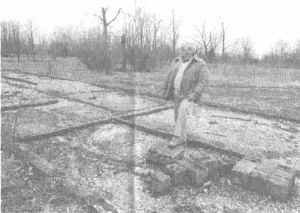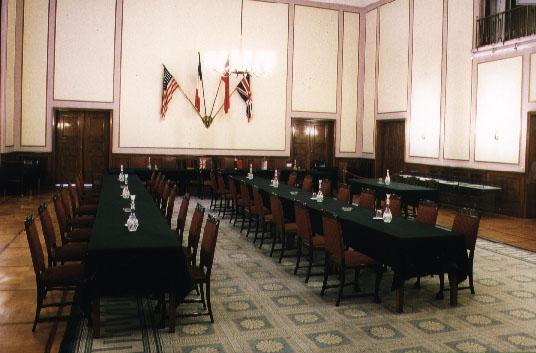| the Republic Columbus, Indiana date unknown Camp Atterbury's Old POW Camp Just a
Memory
All is quiet now. Gone is the sound of marching boots, the groaning engines of hulking military vehicles and the distant report of rifles and artillery fired in preparation for battle. Gone too, is the chatter of foreign voices. Concrete building foundations, footings for guard towers and a few lonely fire hydrants are about all that remain of the Camp Atterbury prisoner-or-war compound, once home to as many as 10,000 foreign troops during World War II. "A lot them didn't want the war, they didn't want to fight," James Streeval, 503 S. Walnut in Edinburgh, said of the Italian and German soldiers housed a the POW camp during its operation from early 1943 until June 27, 1946. Streeval, 68, often worked with the POWs as a civilian mechanic at Camp Atterbury during the mid-1940s. He returned to the camp during the Korean Conflict and retired two years ago after working 30 years at Alma Plastics Company in Edinburgh. The 20 to 30 acres that was the compound lie along Stone Arch Road and form the northernmost portion of a land parcel that fans out south toward Hospital Road, bordered by the Atterbury Fish and Wildlife Area and the Atterbury Job Corps Center, said retired Colonel Richard R. King, civilian chief of staff at the Atterbury Reserve Forces Training Area and a former post commander. The land has been licensed to the Indiana Department of the Military for use as an artillery firing range and tactical training area, King said. The Army moved quickly to dismantle the POW camp after its deactivation, salvaging what it wanted and selling off what it could of the rest. During its operating days, the POW camp was commanded by the late Colonel John L. Gammell, father of Columbus physician Dr. Lindley L. Gammell, 57. Two sets of barbed wire fence surrounded the compound with guard towers containing search lights stationed between the fences. Most POWs held at Atterbury had been captured in Africa, said the younger Gammell, who was then about age 16 or 17. The camp held Italian soldiers until Italy surrendered in September 1943 and then began to take in German prisoners. German troops included some of General Erwin Rommel's elite Africa Korps, "Every one, built big and strong," he noted. Gammell recalls one German POW escaped but turned himself in after five days because he apparently could find nowhere else to go. Published reports indicate a few other prisoners escaped but were recaptured. Italian POWs had their own camp orchestra and received permission to build a chapel just outside the compound fence, the "Chapel in the Meadow" now standing along Stone Arch Road. Catholic mass was held weekly during the Italians' stay, Gammell said. Prisoners also had opportunities for recreation and other activities. Gammell said his father had no problems maintaining order at the camp. American requests or other communications were presented to Italian or German officers, who then directed their men. His father's reputation for fairness once started a rumor that the younger Gammell, then fighting overseas, had been captured by German forces, leading his father to treat POWs fairly to insure fair treatment for his son. Gammell said the Army also often hired out POWs to area farmers and manufacturers because of the war-time labor shortage. He recalls one instance where farmers and canning companies in the area hired POWs to pick tomatoes but set the daily picking quota at double what they thought possible for the men. The POWs made the quota in half a day, he said. The farmers and canning companies then tried to redouble the quota, but Gammell said his father prohibited it because the move would violate prisoners' rights under the Geneva Convention. Dressed in blue denim pants, shirts and jackets, all marked with "PW" in large white letters, POWs also de-tasseled corn, picked beans and did other agricultural work at Camp Atterbury and in Bartholomew and surrounding counties. They filled a void in the available labor supply, said Tachel Henry, 65, of Franklin Route 2, whose father hired prisoners to pick apples at the family's Saunders Orchard on Indiana 252 at the north end of Camp Atterbury. POWs never caused any problems, said Mrs. Henry, the curator of the Johnson County Museum. "I know when they had the Italians, the guard would just go lie down under a tree," she added. She believes guards seemed to watch German soldiers a little more closely, however. At Camp Atterbury, Streeval recalls seeing German POWs cutting weeds, feeding coal-fired stoves and working in garages, kitchens and laundries. "You kinda had to keep a eye on the," but most POWs at his garage seemed to be good workers, he said. "If anything came in there with a machine gun mount, you could just figure they were not going to touch it," he said. "They'd say, 'That kills my brother. That kills my brother,' and they just wouldn't do it." Streeval said the Italians seemed more friendly than the Germans, who generally kept to themselves - "They didn't want any more to do with American people that they had to." POWs often carried coffee to work each morning in old liquor or beer bottles they had found, he recalled. "Anything you had to eat that you didn't want, all you had to do is hold it up and they'd take it", he added. Prisoners listened regularly to the radio while working at the garage but disliked hearing news about defeats suffered by their countries, he said. Many did not speak English but some of those who did often talked about their families. "Some of them were pretty good people, and some were trusted not too far," he said. "Some, well, they were just like us." Streeval says he still can see faces of POWs he worked with but never has heard from them. "I've often thought about it, you know, if they are still living, or what in the world did happen to them." |
|
'America beats by far anything,' said the ex-POW In WWII, thousands of captive Germans found our prison camps so hospitable that they later became U.S. citizens From the start, our POW policy was driven by an intent to ensure the safety of Americans in Nazi hands. So scrupulously did we hew to the 97 Geneva Conventions that many Americans thought the prisoners were being coddled. It didn't take long, however, for word about the good conditions in all 644 U.S. POW camps to reach the European front. As former POWs at a reunion in Arizona relate in this story, prisoners had room and board better than that provided by the German army, and eventually were allowed to work on farms and in factories. Add to that educational and recreational programs that served as subliminal instruments of de-Nazification, and the country ended up with many POWs who, after the war, chose to return to the land of their captors. Abstract of an article by Jack Fincher, originally published in June 1995 Smithsonian. All rights reserved. 1996 Smithsonian Magazine All rights reserved. |


 Page last revised
08/30/2022
Page last revised
08/30/2022